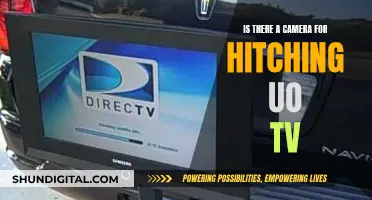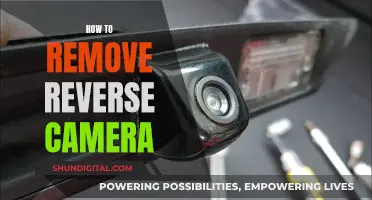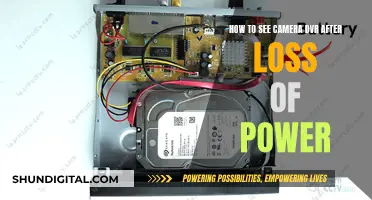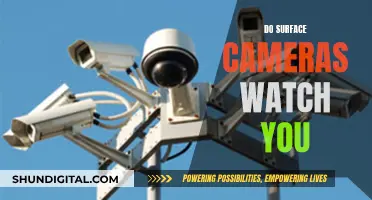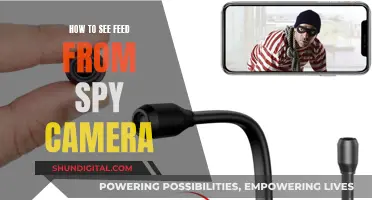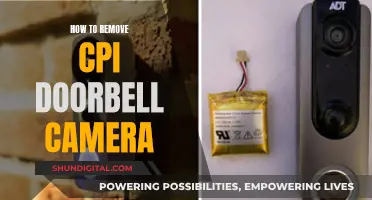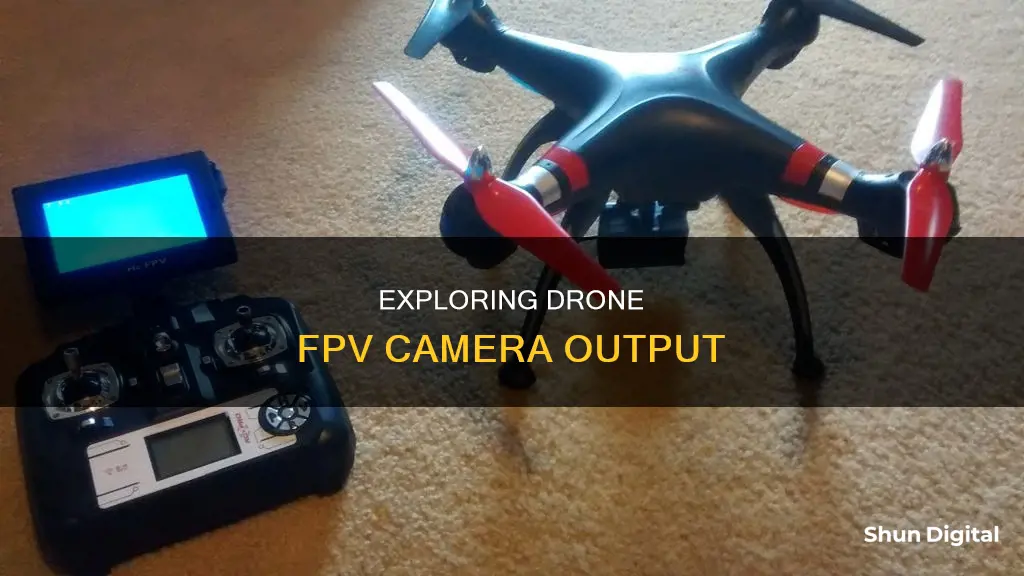
First-person-view (FPV) cameras are a key component in FPV drone systems, allowing pilots to see a live feed of what the drone sees. FPV cameras are small, lightweight, and reasonably priced. They can be mounted onto a drone to send real-time video to the pilot's remote control screen, monitor, smartphone, tablet, or FPV goggles.
FPV systems fall into two categories: analog and digital. Analog FPV cameras are not compatible with digital FPV systems and vice versa.
The FPV camera translates light into a video signal, which is then sent to a video transmitter (VTX) and wirelessly transmitted to a video receiver (VRX). The VRX then decodes the signal so it can be viewed on a screen.
There are several ways to record footage from an FPV camera, including using FPV goggles with a built-in DVR, a video transmitter with onboard recording capabilities, or an external DVR for analog setups.
| Characteristics | Values |
|---|---|
| Camera Quality | 600TVL, 700TVL, 1000TVL |
| Camera Power Source | 12V Lipo battery |
| Camera Connection to Transmitter | Three wires (red, black and yellow) |
| Receiver Setup | Connect three connectors (yellow, white and red) of the RC832 receiver to the respective three connectors of the FPV connector |
| Receiver Power Source | 11.1V Lipo battery |
| Video Output on Monitor | 3.5mm headphone jack |
| Video Output Connection to Laptop | RTMP feed or 3.5mm AV jack to phono conversion cable |
| Video Output Connection to Android Mobile | 5.8G UVC OTG 150CH Channel FPV Receiver for Android mobile |
| Video Output Connection to PC | 5.8G UVC OTG 150CH Channel FPV Receiver |
| Video Format | PAL or NTSC |
What You'll Learn
- FPV cameras are small, light and reasonably priced
- FPV cameras allow you to see where the drone is flying and what it is seeing
- The FPV transmitter will send the live video signal to your Remote Control screen, monitor, smartphone device, tablet or FPV goggles
- FPV cameras have ultra-low latency, wide dynamic range, and provide vital visual information for FPV drone pilots
- FPV systems fall into two categories: analog and digital

FPV cameras are small, light and reasonably priced
FPV cameras are small, light, and reasonably priced. They are mounted onto drones to transmit real-time video to the ground using a video transmitter. This allows the pilot to see where the drone is flying and what it is seeing. The live video signal can be sent to a remote control screen, monitor, smartphone, tablet, or FPV goggles.
FPV cameras are typically small and lightweight to reduce the overall weight of the drone. This helps to improve the drone's speed, agility, and battery life. The compact size of FPV cameras also allows them to be easily mounted on a variety of drones, from small consumer drones to large military drones.
In terms of pricing, FPV cameras are generally affordable and accessible to a wide range of users. The cost of FPV cameras can vary depending on factors such as image quality, brand, and additional features. However, they are often reasonably priced, making them a popular choice for drone enthusiasts.
FPV cameras use either a CMOS or CCD sensor. CMOS cameras are typically cheaper and more widely available, making them a common choice for drone pilots. They are also lighter and use less power, which can be advantageous for certain types of drones. CCD sensors, on the other hand, offer better image quality and are less susceptible to the jello effect due to their global shutter. However, they tend to be more expensive.
Overall, the small size, light weight, and reasonable pricing of FPV cameras make them a popular choice for drone users, whether they are flying small consumer drones or large high-end drones.
Uncover Hidden Cameras: Comprehensive Room-Sweeping Guide
You may want to see also

FPV cameras allow you to see where the drone is flying and what it is seeing
FPV stands for first-person view. FPV cameras are small, light, and reasonably priced. They are mounted onto a drone and use a video transmitter to send real-time video to the ground. This allows the user to see where the drone is flying and what the drone sees through their remote control screen, monitor, smartphone device, tablet, or FPV goggles.
FPV drones offer an immersive flying experience and allow for more precise flying and better accuracy. The low-latency transmission makes for quicker reactions and better awareness of surroundings. FPV drones are perfect for surveying, aerial photography, security, and drone racing.
The FPV camera image sensor will affect its performance. FPV cameras use either a CMOS or CCD sensor. CCD sensors capture better-quality images but are more expensive and use more power. CMOS cameras are cheaper, lighter, and more widely available.
If you are using a separate HD camera for FPV, such as a GoPro, you can connect it to a video transmitter to get a live video feed. However, these setups tend to have latency issues. Dedicated FPV cameras have much lower latency, which is important for drone racing.
Knifing a TV: Cameras, Microphones, and Privacy
You may want to see also

The FPV transmitter will send the live video signal to your Remote Control screen, monitor, smartphone device, tablet or FPV goggles
The FPV transmitter is a crucial component of the FPV system, wirelessly transmitting camera images to your device of choice. The FPV transmitter will send the live video signal to your Remote Control screen, monitor, smartphone device, tablet or FPV goggles.
To set up your FPV system, you will need to connect your camera to the transmitter. The camera can obtain power via the transmitter, but it is important to note that different cameras require different operating voltages. You will need to check the camera specifications to determine the required voltage. If your camera requires 12V voltage, you can connect it directly to the transmitter via the three wires (red, black, and yellow). For cameras that require 6V or below, you will need to power the camera via a BEC (DC step-down) converter, connecting the red and black wires to the 6V BEC and the yellow wire to the transmitter.
Once your camera and transmitter are connected, you can install the camera at the front of the drone and the transmitter at the back. You can then power the transmitter from the drone via the power distribution board.
To view the live video feed on a monitor or TV, you will need an FPV receiver such as the RC832 5.8G 32ch Audio/Video receiver. Connect the three connectors (yellow, white, and red) of the receiver to the respective connectors of the FPV monitor or TV. If you are using a TV, make sure to switch it to AV mode. The RC832 receiver also requires a power source, such as an 11.1V Lipo battery.
If you prefer to use your smartphone or PC, there are alternative options available. For Android phones, you can use the 5.8G UVC OTG 150CH Channel FPV Receiver, which requires your phone to have UVC OTG capability. Simply download and install an FPV camera app from the Google Play Store, connect the receiver to your phone, and tune the receiver by pressing its button. For PCs, you can use the same receiver by downloading and installing video capture software and connecting the receiver via a mini USB cable.
By following these steps, you can set up your FPV system and view the live video feed from your drone on your preferred device.
Accessing Geeni Cameras on PC: A Step-by-Step Guide
You may want to see also

FPV cameras have ultra-low latency, wide dynamic range, and provide vital visual information for FPV drone pilots
FPV cameras are small, lightweight, and reasonably priced. They are mounted onto drones to transmit real-time video to the pilot on the ground. FPV stands for First-Person-View, and these cameras allow the pilot to see where the drone is flying and what it is seeing.
FPV cameras have ultra-low latency, which is vital for drone racing. The latency of your FPV camera is caused by the camera processing information from the image sensor. The faster the processing, the lower the latency. Dedicated FPV cameras have a latency of less than 40 ms, while action cameras like the GoPro have a latency of 140 ms or more. Lower latency allows pilots to react more quickly and avoid potential obstacles or crashes.
FPV cameras also have a wide dynamic range, which is important for flying in varying light conditions. A good camera should allow the pilot to see as much detail as possible in shadows while preventing the sky from being overexposed. This helps the pilot to avoid obstacles and crashes.
The live video signal from an FPV camera can be transmitted to a remote control screen, monitor, smartphone device, tablet, or FPV goggles, depending on the drone setup. FPV technology allows pilots to fly drones at higher altitudes and further distances, with some drones able to fly up to 5 miles away using FPV.
In addition to ultra-low latency and wide dynamic range, FPV cameras also provide vital visual information for FPV drone pilots to navigate and perform maneuvers. With advancing technology, some FPV cameras now offer onboard recording with image quality rivalling that of action cameras.
Hidden Cameras in TVs: Fact or Fiction?
You may want to see also

FPV systems fall into two categories: analog and digital
Analog systems transmit raw analog data, varying the amplitude or frequency of the wave. They are prone to external noise and interference, and the image quality is often comparable to watching an old TV with a poor signal. However, analog systems are affordable, lightweight, and widely available, making them a popular choice for FPV drone users, especially those on a budget or looking for racing drones.
On the other hand, digital systems first encode the signal as ones and zeros before transmission. They offer superior image quality and are less susceptible to external noise. Digital systems, such as those from DJI, provide exceptional video quality and are ideal for freestyle flying and long-range capabilities. However, they are generally more expensive and may have higher latency, which can be a concern for racing drones.
Both analog and digital systems have their advantages and disadvantages, and the choice between the two depends on the user's budget, intended use, and performance requirements.
A Guide to Operating HD IR Camera Watches
You may want to see also
Frequently asked questions
FPV stands for First-Person-View. An FPV camera is a small, lightweight camera that can be mounted onto a drone to send real-time video to the pilot on the ground. This allows the pilot to see what the drone sees and helps with navigation and performing maneuvers.
To connect an FPV camera to your drone, you will need to connect the camera to a video transmitter (VTX) and power it from the drone's power distribution board. The camera can obtain power directly from the transmitter or, if it requires a lower voltage, via a BEC (DC step-down) converter.
The output from an FPV camera can be viewed on various devices such as a dedicated FPV monitor, a TV, a smartphone, a tablet, or FPV goggles. To receive the video signal, you will need a video receiver (VRX) that is compatible with your FPV system.


